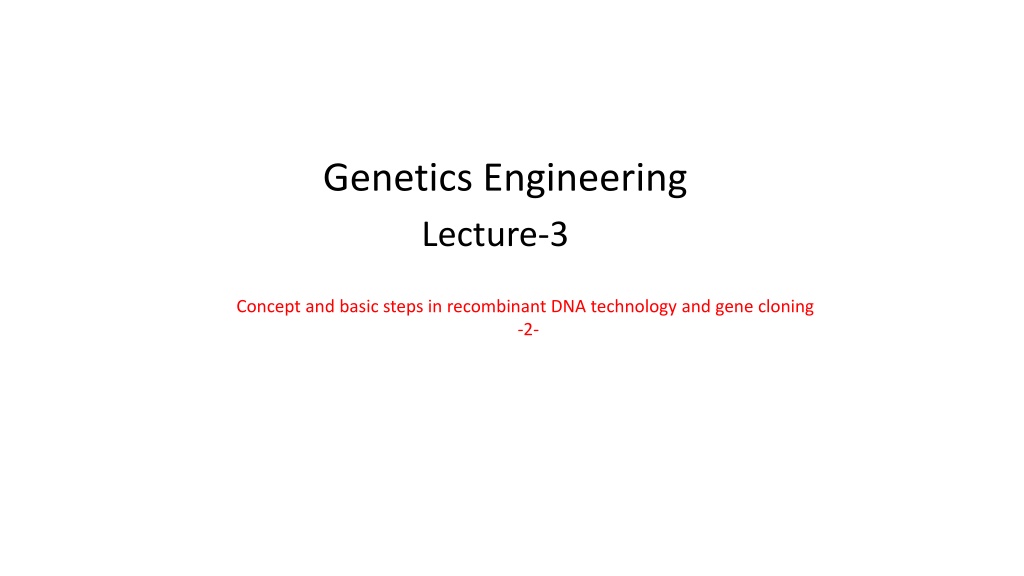Understanding Recombinant DNA Technology and Gene Cloning
Recombinant DNA technology is crucial for developing new vaccines and pharmaceuticals by combining genetic material from various sources to create unique sequences. Techniques like transformation, non-bacterial transformation, and phage introduction are used to make recombinant DNA. Tools like enzymes, vectors, and host organisms facilitate this process, leading to benefits like improved crops, recombinant vaccines, and gene therapy. DNA analysis methods and PCR, with Taq polymerase and PCR primers, play key roles in amplifying and analyzing specific DNA regions for various applications.
Download Presentation

Please find below an Image/Link to download the presentation.
The content on the website is provided AS IS for your information and personal use only. It may not be sold, licensed, or shared on other websites without obtaining consent from the author. Download presentation by click this link. If you encounter any issues during the download, it is possible that the publisher has removed the file from their server.
E N D
Presentation Transcript
Genetics Engineering Lecture-3 Concept and basic steps in recombinant DNA technology and gene cloning -2-
Recombinant DNA technology Recombinant DNA technology is playing a vital role in improving health conditions by developing new vaccines and pharmaceuticals. Recombinant DNA is DNA molecules formed by laboratory methods of genetic recombination (such as molecular cloning) to bring together genetic material from multiple sources, creating sequences that would not be found in the genome
How is Recombinant DNA made: see lecture (1) Transformation: 1- select a piece of DNA to be inserted into a vector. 2- cut that piece of DNA with a restriction enzyme 3- ligate the DNA insert into the vector with DNA Ligase. The insert contains a selectable marker which allows for identification of recombinant molecules. Non-BacterialTransformation: This is a process very similar to Transformation, The only difference between the two is non-bacterial does not use bacteria as a host. In microinjection, the DNA is injected directly into the nucleus of the cell being transformed. Phage Introduction: Phage introduction is the process of transfection, which is equivalent to transformation, except a phage is used instead of bacteria.
Tools of recombinant DNA technology: 1- The enzymes which include the restriction enzymes 2-The vectors. 3-Host organism Benefits pf Recombinant DNA: Better Crops (drought & heat resistance). Recombinant Vaccines (Hepatitis B). Prevention and cure of sickle cell anemia. Production of clotting factors. Production of insulin. Plants that produce their own insecticides. gene therapy.
Polymerase chain reaction (PCR) PCR is a common laboratory technique used to make many copies of a particular region of DNA PCR product can be utilized in sequencing, or cloned into a plasmid for further experiments.
Taq polymerase and PCR primers Taq replication in an organism, PCR requires a DNA enzyme that makes new strands of DNA, using existing strands as templates. The DNA polymerase typically used called Taq polymerase, after the heat-tolerant bacterium which it (Thermus aquaticus). polymerase Like DNA PCR primers are short pieces of single-stranded DNA, usually around 20 nucleotides. Two primers are used in each PCR reaction, and they are designed so that they flank the target region (region that should be copied). polymerase in PCR is That is, they are given sequences that will make them bind to opposite strands of the template DNA, just at the edges of the region to be copied. The primers bind to the template by complementary base pairing. from was isolated
PCR steps: Denaturation Heat the reaction strongly to separate, or denature, the DNA strands. This provides single-stranded template for the next step. Annealing: Cool the reaction so the primers can bind to their complementary sequences on the single-stranded template DNA Extension: Raise the reaction temperatures so Taq polymerase extends the primers, synthesizing new strands of DNA.
Gel electrophoresis Gel technique used to separate DNA fragments PCR product, based on their size and charge. the molecules will travel through the gel in different directions or at different speeds, them to be separated from one another. electrophoresis is a allowing
As the gel runs, shorter pieces of DNA will travel through the pores of the gel matrix faster than longer ones. After the gel has run for awhile, the shortest pieces of DNA will be close to the positive end of the gel, while the longest pieces of DNA will remain near the wells.
gel is stained with a DNA- binding dye Ethidium bromide or SYBR) and placed under UV light, the DNA fragments will glow, allowing us to see the DNA present at different locations along the length of the gel (Example
DNA sequencing DNA sequencing is the process of determining the sequence of nucleotide bases (As, Ts, Cs, and Gs) in a piece of DNA. Sequencing an entire genome (all of an organism s DNA) remains a complex task. It requires breaking the DNA of the genome into many smaller pieces, sequencing the pieces, and assembling the sequences. DNA Sequencing methods: Sanger sequencing: 900 base pair or less Next-generation sequencing: (The most recent set of DNA sequencing technologies)























